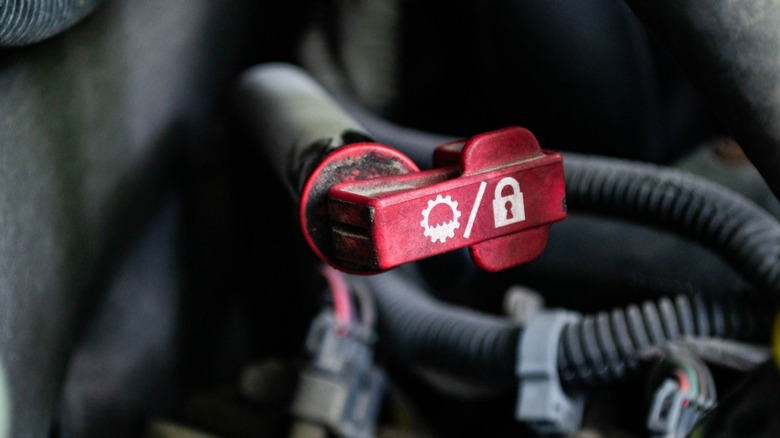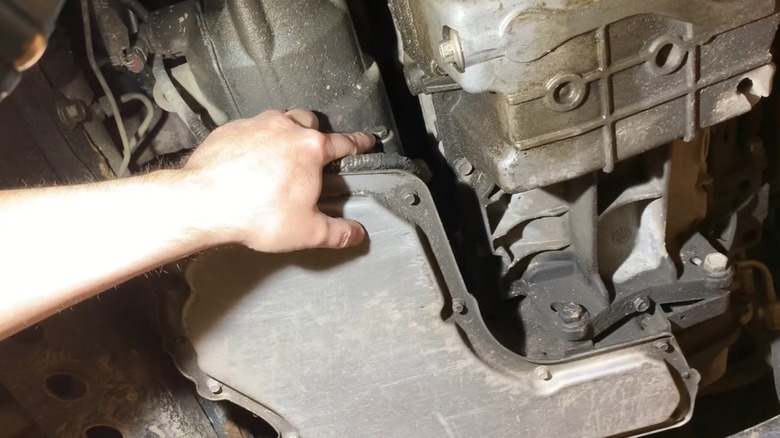How To Check Your Transmission Fluid Level (And How Often You Should)
When it comes to cars, the transmission or gearbox is one of the most vital components. This part is responsible for scaling engine power output to different driving situations, like accelerating and decelerating, as well as for sending that power to the axles and wheels. There are various different types of transmissions that you can find in modern vehicles, including traditional manual transmissions, automatic transmissions, and continuously variable transmissions (CVTs). Regardless of the type of transmission your car has, it relies on a special type of hydraulic fluid to help provide lubrication and actuate gear changes.
Like the different types of transmissions, there are also various types of transmission fluid, each requiring distinct services and maintenance. As with all the automotive fluids that your vehicle uses, transmission fluid must be replaced periodically, and it's critical that you check the level and condition regularly in between changes. While there isn't a set interval for checking the fluid like there is when it comes to replacing it, you should inspect the level and condition at least once a month.
Depending on the type of vehicle you drive and its gearbox, checking the transmission fluid can be relatively easy or complex. For cars that have transmissions with engine bay dipsticks, checking the fluid is basically as easy as checking the oil. However, vehicles with sealed transmissions (i.e., those without dipsticks) require you to go under the car to check the fluid level and condition. If you're interested in learning exactly how to check both types of transmissions, stick around. Here's everything you need to know.
How to check the transmission fluid level with a dipstick
If your vehicle has a transmission with an engine bay dipstick, checking the fluid level is relatively easy. Note that various types of transmissions can be sealed or unsealed, including manual, automatic, and CVTs, so knowing the type of transmission your car uses won't help you to determine whether it's sealed or not. Instead, pop the hood and look for a dipstick toward the back of the engine bay. Transmission fluid dipsticks usually say transmission or have a gear shape on the handle, and, as mentioned, this dipstick will be closer to the back of your engine bay than the engine oil dipstick.
Once you've located the dipstick, turn your car on and allow the engine to warm up. Once the engine has reached its normal operating temperature, remove the dipstick and inspect the fluid. Transmission fluid can be various colors, but it's commonly a reddish-pink hue. If the fluid is extremely dark or feels grimy, it could mean that it's time for a replacement. Next, wipe the dipstick off with a rag or towel and reinstall it in the tube. Pull it out once again and check the fluid level. Like an engine oil dipstick, your transmission fluid dipstick should have markers that indicate the proper fluid level. Check to make sure the fluid falls within these markings, and don't be afraid to wipe the dipstick off and reinsert it several times to be sure that the level is correct.
If the fluid level is too low, you can top it off by placing a thin funnel into the dipstick tube. Then, slowly add fluid while checking the level. Be careful not to overfill the transmission, because you'll have to crawl under the car to drain some out if you do so.
How to check a sealed transmission's fluid level
If your car's engine bay does not contain a transmission fluid dipstick, it means that your vehicle uses a sealed transmission. These types of gearboxes are not designed with DIYers in mind, and if you're not an experienced home mechanic, you may want to consider visiting a pro to get your fluid checked. If you are willing to get a little dirty and check the fluid yourself, you'll need to do so from beneath the vehicle.
Depending on your car, that may mean that you need some type of automotive jack to raise the vehicle off the ground. Once you're able to fit under the car, turn on the engine and let it warm up to a regular operating temperature. Then, slide under the vehicle and locate the gearbox. Once you've identified the transmission, look for the fill/inspection plug, which you can usually find on the upper side of the gearbox. It's common for these plugs to use Allen key or inverted hex-head fasteners, although they can be regular hex-head bolts, too. To check the fluid level and condition, remove the fill/inspection plug. The transmission fluid should be roughly at the same level as the hole, and a small amount of fluid should spill out.
Besides checking the level, you should also inspect the fluid's condition. As mentioned above, transmission fluid is usually a pink-red color. If the fluid is extremely dark or contains grime and debris, it's generally a pretty solid sign that it's time for a replacement.


